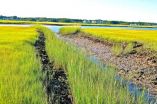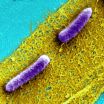(Press-News.org) PROVIDENCE, R.I. [Brown University] — After decades of decline, grasses have returned to some once-denuded patches of Cape Cod's saltmarshes. To the eye, the marsh in those places seems healthy again, but a new study makes clear that a key service of the marsh – coastal protection – remains diminished.
"We've got the aesthetics back but the ecosystem function hasn't come back," said ecologist Mark Bertness, professor of biology at Brown and senior author of the study in the journal Biological Conservation. "The metric of a recovered habitat should not be 'Does it look like a recovered habitat?' but 'Does it restore the ecosystem services?', which is really what should be important to us."
Bertness and his lab members have been studying the marshes for years. In particular they have tracked the fate of the grass Spartina alterniflora, which their research has found to be the victim of herbivorous Sesarma purple marsh crabs run amok. Recreational fishing has depleted the crab's predators, Bertness said, resulting in die-off where recreational fishing is prominent.
But in some places the grasses have been growing back in, in part thanks to the invasion of a new predator of Sesarma. Given that positive development, Bertness and co-authors and former students Caitlin Brisson and Tyler Coverdale set out in the summer of 2013 to determine whether the recovering marshes were again providing the essential service of buffering the Cape's coast against the Atlantic Ocean's waves.
The answer is that the recovering ecosystems were not back to performing like healthy ones. In the team's measures of wave exposure, wave force, and changes in sediment height, recovering marsh creek banks did better than ones that still had extensive die-off, but were notably worse than marshes that have always remained healthy.
Measuring Marshes
To make their measurements, the team visited marshes in all three stages of health. Because of their extensive research in the area, they had already set posts in many marshes in 2009 to measure sediment heights. Last summer they also measured the amount of grass, both in terms of the density of stalks, as well as above- and below-ground biomass of samples. They also set standard-sized chalk blocks at equal elevations at all sites and deployed instruments that measure wave speed.
Always-healthy marshes, they found, had the highest grass stem density of 637 per square meter, while recovering marshes had 448 and dying marshes had only 156. Biomass was also higher in healthy marshes than recovering ones and much higher than in dying ones.
The purpose of the chalk is to slowly dissolve upon exposure to the waves, thereby showing which marshes are most successful in dampening incoming water. In recovering marshes the chalk blocks dissolved 48.4 percent more than in always healthy ones. The wave speed sensors showed the same pattern. The healthy marshes slowed the waves the most. Recovering marshes slowed them somewhat less and dying marshes held them back the least.
Finally, while healthy marshes experienced a slight increase in sediment height between 2009 and 2013, sediments continued to decline somewhat in recovering marshes. Sediments declined more dramatically in dying marshes, the data show.
Prevention and Real Restoration
Among the many services that saltmarshes provide, coastal protection is of particular importance as sea levels rise due to climate change, Bertness said. Based on this study's findings, he said he is concerned that people just eyeballing the marshes may become complacent about the pace of this service's recovery.
Ecological restoration is a complicated and expensive endeavor that sometimes fails because of the subtle and intricate nature of ecosystems, Bertness noted. In the case of Cape Cod's marshes, among the key species that may have been set back are the slow-growing mussels that transfer nitrogen from the water to the sediment, promoting grass growth.
"One of the things that happens when you have one of these predator-depletion-triggered die-offs is that you lose a lot of the positive feedbacks, which is really going to slow the recovery," Bertness said. "If you slow the recovery you basically leave room for all kinds of things to intervene so that the recovery never gets completed."
The study is a reminder, therefore, that ecosystem management cannot be judged as successful based merely on how the marshes look. In the best case, he said, the remaining healthy marshes would never die-off at all.
"We need to prevent the die-off or understand the recovery enough to do management conservation tasks, such as fertilization, that would enhance the recovery," Bertness said.
INFORMATION:
The National Science Foundation funded the research (grant: NSF BIO OCE-0927090).
Cape Cod saltmarsh recovery looks good, falls short
2014-09-17
ELSE PRESS RELEASES FROM THIS DATE:
Recruiting bacteria to be technology innovation partners
2014-09-17
For most people biofilms conjure up images of slippery stones in a streambed and dirty drains. While there are plenty of "bad" biofilms around – they even cause pesky dental plaque and a host of other more serious medical problems – a team at the Wyss Institute for Biologically Inspired Engineering at Harvard University sees biofilms as a robust new platform for designer nanomaterials that could clean up polluted rivers, manufacture pharmaceutical products, fabricate new textiles, and more.
In short, they want to give biofilms a facelift, and have developed a novel protein ...
Phthalates heighten risk for childhood asthma
2014-09-17
Researchers at the Columbia Center for Children's Environmental Health at the Mailman School of Public Health are the first to demonstrate an association between childhood asthma and prenatal exposure to two phthalates used in a diverse array of household products. Results appear online in the journal Environmental Health Perspectives.
Children born to mothers exposed during pregnancy to higher levels of the chemicals, butylbenzyl phthalate (BBzP) and di-n-butyl phthalate (DnBP) had a 72 percent and 78 percent increase in risk of developing asthma between age 5 and 11, ...
New study examines the impact of socioeconomic position & maternal morbidity in Australia
2014-09-17
The risk of severe maternal morbidity amongst women in Australia is increased by lower socioeconomic position, suggests a new study published today (17 September) in BJOG: An International Journal of Obstetrics and Gynaecology.
Australians generally enjoy high standards of living; however, existing research has concluded that health disparities exist, in particular between indigenous and non indigenous Australians.
This case-control study aimed to explore the independent impact of socioeconomic position on severe maternal morbidities associated with direct maternal ...
A greater focus on socially disadvantaged women is needed to improve maternity care in England
2014-09-17
Women from lower socioeconomic groups in the UK report a poorer experience of care during pregnancy and there needs to be a greater focus on their care, suggests a new study published today (17 September) in BJOG: An International Journal of Obstetrics and Gynaecology (BJOG).
Differences in health outcomes amongst different socioeconomic groups have been demonstrated in many areas and have provided the focus for national initiatives in the UK to reduce the observed inequalities.
The Oxford University study, funded by the National Institute for Health Research, explores ...
NAMS issues first comprehensive recommendations on care of women at menopause and beyond
2014-09-17
CLEVELAND, Ohio (September 17, 2014)—The North American Menopause Society (NAMS) has published its key, evidence-based recommendations for the comprehensive care of midlife women—on everything from hot flashes to heart disease. The special feature, "The North American Menopause Society Recommendations for Clinical Care of Midlife Women," was published online today in the Society's journal Menopause. This is the first, comprehensive set of evidence-based recommendations for the care of midlife women freely available to all clinicians who care for women at this stage of life. ...
Sharks' skin has teeth in the fight against hospital superbugs
2014-09-17
Transmission of bacterial infections, including MRSA and MSSA could be curbed by coating hospital surfaces with microscopic bumps that mimic the scaly surface of shark skin, according to research published in the open access journal Antimicrobial Resistance and Infection Control.
The study modelled how well different materials prevented the spread of human disease bacteria through touching, sneezes or spillages. The micropattern, named Sharklet™, is an arrangement of ridges formulated to resemble shark skin. The study showed that Sharklet harboured 94% less MRSA bacteria ...
Violent origins of disc galaxies probed by ALMA
2014-09-17
An international research group led by Junko Ueda, a Japan Society for the Promotion of Science postdoctoral fellow, has made surprising observations that most galaxy collisions in the nearby Universe — within 40 million light-years from Earth — result in so-called disc galaxies. Disc galaxies — including spiral galaxies like the Milky Way and lenticular galaxies — are defined by pancake-shaped regions of dust and gas, and are distinct from the category of elliptical galaxies.
It has, for some time, been widely accepted that merging disc galaxies would eventually form ...
Global shift away from cars saves US$100 trillion, eliminates 1,700 MT of CO2 pollution
2014-09-17
NEW YORK (17 September, 2014)—More than $100 trillion in cumulative public and private spending, and 1,700 megatons of annual carbon dioxide (CO2)—a 40 percent reduction of urban passenger transport emissions—could be eliminated by 2050 if the world expands public transportation, walking and cycling in cities, according to a new report released by the University of California, Davis, and the Institute for Transportation and Development Policy (ITDP).
Further, an estimated 1.4 million early deaths could be avoided annually by 2050 if governments require the strongest ...
'Smart material' chin strap harvests energy from chewing
2014-09-17
A chin strap that can harvest energy from jaw movements has been created by a group of researchers in Canada.
It is hoped that the device can generate electricity from eating, chewing and talking, and power a number of small-scale implantable or wearable electronic devices, such as hearing aids, cochlear implants, electronic hearing protectors and communication devices.
The first results of the device's performance have been published today, 17 September, in IOP Publishing's journal Smart Materials and Structures.
Jaw movements have proved to be one of the most promising ...
World Alzheimer Report 2014 reveals persuasive evidence for dementia risk reduction
2014-09-17
The World Alzheimer Report 2014 'Dementia and Risk Reduction: An analysis of protective and modifiable factors', released today, calls for dementia to be integrated into both global and national public health programmes alongside other major non communicable diseases (NCDs).
Alzheimer's Disease International (ADI) commissioned a team of researchers, led by Professor Martin Prince from King's College London, to produce the report. ADI is publishing this report, in conjunction with World Alzheimer's Day™ (21 September) and as a part of World Alzheimer's Month, an international ...




